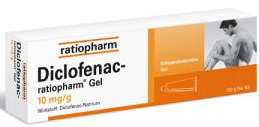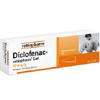  | Diclofenac Gel is an NSAID, used to treat the symptoms of pain and inflammation. Active Ingredient: diclofenac Availability: In Stock (25 packages) View all Analogs of Diclofenac Gel: Diclofenac Voltaren |
| Product name | Per Pill | Savings | Per Pack | Order |
|---|---|---|---|---|
| 4 1% gels | $9.13 | $36.51 | ADD TO CART | |
| 6 1% gels | $8.15 | $5.84 | $54.76 $48.92 | ADD TO CART |
| 8 1% gels | $7.67 | $11.68 | $73.01 $61.33 | ADD TO CART |
| 10 1% gels | $7.37 | $17.52 | $91.27 $73.75 | ADD TO CART |
| 12 1% gels | $7.18 | $23.37 | $109.53 $86.16 | ADD TO CART |
| 14 1% gels | $7.04 | $29.21 | $127.78 $98.57 | ADD TO CART |
| 16 1% gels | $6.94 | $35.05 | $146.04 $110.99 | ADD TO CART |
Drug Uses
Diclofenac Gel is used for treating pain in certain joints (e.g., in the knees or hands) caused by osteoarthritis. It may also be used for other conditions as determined by your doctor.
How to use
Use Diclofenac Gel as directed by your doctor.
Do not apply Diclofenac Gel to infected skin; open wounds; or red, swollen, or peeling skin.
Use the provided dosing card to measure your dose of Diclofenac Gel. Ask your pharmacist if you have any questions about how to use the dosing card or Diclofenac Gel;
Gently massage Diclofenac Gel into the skin of the affected area. Allow the medicine to dry for at least 10 minutes before you wear clothes or gloves over the treated area.
After using the dosing card, fold it in half (with the used side inside) and throw it away out of the reach of children and pets.
Wash your hands immediately after using Diclofenac Gel unless your hands are part of the treated area.
Do not wrap, bandage, or apply heat to the treated area.
Do not shower, bathe, or wash the treated area for at least 1 hour after you use Diclofenac Gel.
Ask your health care provider any questions you may have about how to use Diclofenac Gel.
Drug Class and Mechanism
Diclofenac Gel is an NSAID. It may work by blocking certain substances in the body that are linked to inflammation. NSAIDs treat the symptoms of pain and inflammation. They do not treat the disease that causes those symptoms.
Missed Dose
If you miss a dose of Diclofenac Gel, skip the missed dose. Go back to your regular dosing schedule. Do not use 2 doses at once.
Storage
Store Diclofenac Gel at room temperature, between 68 and 77 degrees F (20 and 25 degrees C). Store away from heat, moisture, and light. Do not store in the bathroom. Keep in a tight, light-resistant container. Keep Diclofenac Gel out of the reach of children and away from pets.Warnings/Precautions
Do not use Diclofenac Gel if:
you are allergic to any ingredient in Diclofenac Gel;
you have had a severe allergic reaction (e.g., severe rash, hives, trouble breathing, growths in the nose, dizziness) to aspirin or an NSAID (e.g., celecoxib, ibuprofen);
you have recently had or will be having bypass heart surgery;
you have severe kidney problems;
you are in the last 3 months of pregnancy.
Contact your doctor or health care provider right away if any of these apply to you.
Important:
Diclofenac Gel may cause dizziness. This effect may be worse if you take it with alcohol or certain medicines. Use Diclofenac Gel with caution. Do not drive or perform other possibly unsafe tasks until you know how you react to it.
Diclofenac Gel is for external use only. Do not get it in your eyes, nose, or mouth. If you get it in any of these areas, rinse at once with cool water.
Serious stomach ulcers or bleeding can occur with the use of Diclofenac Gel. Using it in high doses, for a long time, smoking, or drinking alcohol increases the risk of these side effects. If you have severe stomach or back pain; black, tarry stools; vomit that looks like blood or coffee grounds; or unusual weight gain or swelling, contact your doctor or emergency room right away.
Do not use more than the recommended dose or use for longer than prescribed without checking with your doctor.
Diclofenac Gel is an NSAID. Before you start any new medicine, check the label to see if it has an NSAID (e.g., ibuprofen) in it too. If it does or if you are not sure, check with your doctor or pharmacist.
Do not take aspirin while you are using Diclofenac Gel unless your doctor tells you to.
Do not use sunscreens, lotions, insect repellants, or other topical medicines on the treated area.
Do not expose the treated area to the sun, sunlamps, or tanning booths.
Diclofenac Gel may cause harm if it is swallowed. If you may have taken it by mouth, contact your poison control center or emergency room right away.
Lab tests, including kidney function, complete blood counts, and blood pressure, may be performed while you use Diclofenac Gel. These tests may be used to monitor your condition or check for side effects. Be sure to keep all doctor and lab appointments.
Pregnancy and breast-feeding: Diclofenac Gel may cause harm to the fetus. Do not use it during the last 3 months of pregnancy. If you think you may be pregnant, contact your doctor. You will need to discuss the benefits and risks of using Diclofenac Gel while you are pregnant. It is not known if Diclofenac Gel is found in breast milk after topical use. Do not breast-feed while taking Diclofenac Gel.Possible Side Effects
Check with your doctor if any of these most common side effects persist or become bothersome:
mild irritation at the application site.
Seek medical attention right away if any of these severe side effects occur:
severe allergic reactions (rash; hives; itching; trouble breathing; tightness in the chest; swelling of the mouth, face, lips, or tongue); bloody or black, tarry stools; change in the amount of urine produced; chest pain; confusion; dark urine; depression; fainting; fast or irregular heartbeat; fever, chills, or persistent sore throat; mental or mood changes; numbness of an arm or leg; one-sided weakness; red, swollen, blistered, or peeling skin; ringing in the ears; seizures; severe headache or dizziness; severe or persistent irritation at the application site; severe or persistent stomach pain or nausea; severe vomiting; shortness of breath; sudden or unexplained weight gain; swelling of hands, legs, or feet; unusual bruising or bleeding; unusual joint or muscle pain; unusual tiredness or weakness; vision or speech changes; vomit that looks like coffee grounds; yellowing of the skin or eyes.
More Information
Diclofenac Gel is to be used only by the patient for whom it is prescribed. Do not share it with other people.
If your symptoms do not improve or if they become worse, check with your doctor.